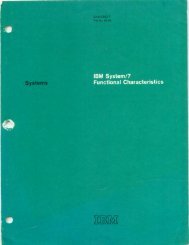Systems Reference Library - All about the IBM 1130 Computing ...
Systems Reference Library - All about the IBM 1130 Computing ...
Systems Reference Library - All about the IBM 1130 Computing ...
- No tags were found...
You also want an ePaper? Increase the reach of your titles
YUMPU automatically turns print PDFs into web optimized ePapers that Google loves.
If a data transfer error occurs while reading aself-describing CCW, data can be placed into <strong>the</strong>'wrong core storage locations, causing destruction ofdata when <strong>the</strong> CCW is executed. If an error in aCCW is capable of causing subsequent commandchaining, it may cause chaining to a write command;<strong>the</strong> result can be alteration of data at <strong>the</strong> I/O device.SkipSkipping suppresses transfer of data to core storageduring a read or sense operation. Skipping is initiatedby turning on <strong>the</strong> skip flag in <strong>the</strong> CCW (bit 4 of<strong>the</strong> second word).The skip function affects only <strong>the</strong> handling ofdata by <strong>the</strong> channel. The operation at <strong>the</strong> controlunit and device proceeds normally, and data istransferred to <strong>the</strong> channel. The channel keeps updating<strong>the</strong> byte count, but does not transfer <strong>the</strong> datato core storage. If <strong>the</strong> chain data flag is on, anew CCW is fetched when <strong>the</strong> byte count reaches0. Normal operation is resumed if <strong>the</strong> skip flagin <strong>the</strong> new CCW is off.Skipping is normally used in conjunction withdata chaining to place only selected portions of datafrom an I/O device into core storage. To accomplishthis, <strong>the</strong> ability to data-chain within a datafield is required. Therefore, <strong>the</strong> skip function isnegated with devices, such as <strong>the</strong> 2311, with datarates that restrict data chaining within data fields.Channel Status WordThe channel status word (CSW) provides a meansfor <strong>the</strong> program to determine <strong>the</strong> status of an I/0device or <strong>the</strong> conditions under which an I/O operationhas been terminated. The CSW is formed, orparts of it replaced, in <strong>the</strong> process of I/O interruptsand during execution of an XIO initialize write (startI/O).The CSW consists of four 16-bit words:Word 1 -- Selector channel status.Word 2 -- Unit address-unit status.Word 3 -- Command address.Word 4 -- Byte count.Selector Channel Status (CSW Word 1)An XIO sense device with modifier bits 13 and 14both off reads <strong>the</strong> selector channel status portion of<strong>the</strong> CSW into <strong>the</strong> accumulator. Whe<strong>the</strong>r an indicatorbit will be on or off is determined by conditions existingat <strong>the</strong> channel, control unit, or device as aresult of processing an I/O instruction.Channel status is updated as it occurs and maybe sensed by <strong>the</strong> program at any time. Figure 109shows <strong>the</strong> various channel status indicators and denotesthose indicators that cause interrupts.NOT OPERATIONAL: This indicator turns on, causingan interrupt, if: (1) <strong>the</strong> control unit addressed byan XIO is not attached to <strong>the</strong> system, or (2) <strong>the</strong> deviceaddress specified by an XIO exceeds <strong>the</strong> numberthat <strong>the</strong> control unit is designed to handle.UNIT STATUS PENDING: This indicator turns on,causing an interrupt, when <strong>the</strong> channel acceptsstatus presented by a control unit or device. Theconditions causing status to be presented to <strong>the</strong> channeldepend on <strong>the</strong> control unit and device.Once status is accepted by <strong>the</strong> channel, pollingis suppressed (preventing overrun of status fromano<strong>the</strong>r control unit or device) until it is reinitiatedby <strong>the</strong> program. This allows <strong>the</strong> program to (1)determine <strong>the</strong> cause of <strong>the</strong> interrupt, (2) sense <strong>the</strong>unit address-status, and (3) reset <strong>the</strong> unit statuspending indicator prior to reinitiation of polling.The unit status pending indicator can be resetonly by sensing <strong>the</strong> unit address-status portion of <strong>the</strong>CSW with an XIO sense device with reset (modifierbits 13, 14, and 15 equal 011).It should be noted that <strong>the</strong> unit address-statusportion of <strong>the</strong> CSW is valid only when sensed inresponse to a unit status pending interrupt.PROGRAM CONTROL INTERRUPT: This indicatorturns on, causing an interrupt, when <strong>the</strong> channelfetches a channel command word (CCW) in which <strong>the</strong>program control interruption flag is on.PROGRAM CHECK: This indicator turns on, causingan interrupt, if ei<strong>the</strong>r of <strong>the</strong> following conditionsis detected:1. An input/output control command (IOCC) has afunction code that is invalid for <strong>the</strong> selectorchannel. Valid function codes are: control(halt I/O) 100, initialize write (start I/O) 101,sense device 111, and sense interrupt level 011.2. An IOCC or CCW has incorrect parity.If a program check occurs during initiation of anoperation, execution of <strong>the</strong> operation is suppressed.If a program check is detected after a device hasbeen started, <strong>the</strong> device is signaled to terminate <strong>the</strong>operation.A program check condition causes commandchaining to be suppressed.CHANNEL DATA CHECK: This indicator turns onif:Selector Channel 205
















